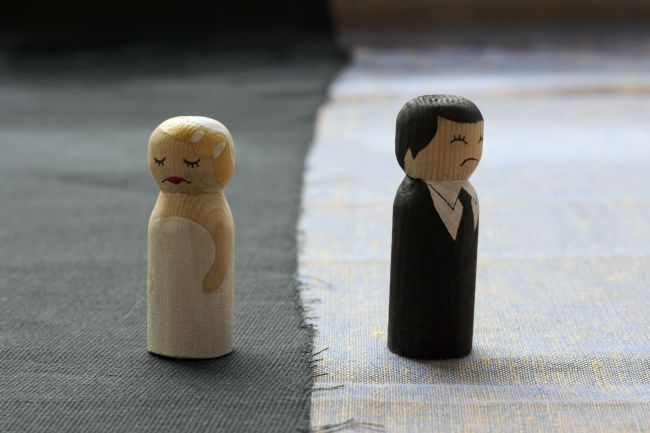Reasons for divorce have changed since ’50s in South Korea: study
By Claire LeePublished : June 17, 2016 - 17:22
The reasons for divorce in South Korea have varied significantly each decade since the 1950s, changing from spouses that have gone missing to basic unhappiness, a study by the Korea Legal Aid Center for Family Relation showed Friday.
The study, which analyzed a total of 1,469,900 pre-divorce counselling cases from 1956-2015, found that historical events and the social climate of each decade, such as the Vietnam War and the 1997 Asian Financial Crisis, influenced couples’ decisions to part ways.
For example, being unfamiliar with the idea of marriage certificates in the 1950s, many “married” women were in fact not even aware of the existence of the legal practice. Some of them ended up being kicked out of their houses and were even forced to leave their children years after their weddings, following their unfaithful husbands’ mistresses registering themselves as legal wives, according to a study by the Seoul Foundation of Women and Family.
The study, which analyzed a total of 1,469,900 pre-divorce counselling cases from 1956-2015, found that historical events and the social climate of each decade, such as the Vietnam War and the 1997 Asian Financial Crisis, influenced couples’ decisions to part ways.
For example, being unfamiliar with the idea of marriage certificates in the 1950s, many “married” women were in fact not even aware of the existence of the legal practice. Some of them ended up being kicked out of their houses and were even forced to leave their children years after their weddings, following their unfaithful husbands’ mistresses registering themselves as legal wives, according to a study by the Seoul Foundation of Women and Family.

Throughout the 1950s and 1960s, 11 percent of all Koreans who sought help at the KLACFR were those who wished to end their de facto marriages. The proportion of those who contacted the institution in hopes of terminating their common-law marriages were the highest during this time period since the Korean War (1950-53), the study showed.
In the 1970s, the proportion of those who wanted to end their marriages as their spouses had been missing for more than three years was the highest among all decades since the 1950s. In the time period, a total of 6.2 percent of all Korean men who sought help at the center wanted a divorce because they could not locate their missing spouses, while 2.6 percent of women who contacted the center were experiencing the same.
“We assume that many of those people lost touch with their spouses during the Korean War,” researchers wrote in the report. “We also assume that some of their spouses went missing after being sent off to the Vietnam War (1955-1975).”
In the 1980s, 35.2 percent of Korean men who contacted the center said they wanted a divorce because their spouses “neglected their spousal duties,” many of them having run away from home. At the same time, 31.3 percent of women said they were mistreated or abused by their husbands. “We think there is a correlation between the high number of husbands whose wives ran away from home and the high number of wives whose husbands were abusive,” researchers wrote in the report.
Meanwhile, the proportion of women who wanted a divorce because of domestic abuse was the highest – 33.5 percent – in the 1990s. The proportion of such women accounted for 21.8 percent of all women who sought help at the center in the 1970s, and 31.3 percent in the 1980s, and 31.7 percent in the 2000s. “We don’t think more women became subject to domestic abuse in the 1990s,” researchers wrote in the report. “Rather, we think the way women perceived domestic violence changed dramatically in the specific time period. More women decided not to tolerate abuse by their spouses.”
In the 2000s, South Korea was hit by the aftermath of the 1997 Asian Financial Crisis. As a result, the proportion of those who sought help at the KLACFR for financial problems, including household debt, increased significantly to 2.8 percent in the 2000s from 0.8 percent in the 1990s.
In the 2010s, the highest proportion of both men and women, 50 percent, said they wanted a divorce for reasons that were not one of the following: infidelity, spousal neglect, physical and emotional abuse and a missing spouse. Researchers said a growing number of Koreans are filing for divorce for reasons that were once considered as trivial by the older generations, such as personality clashes, basic unhappiness and incompatibility.
Also, those who are having conflicts with their spouse over the issue of financially supporting their parents and in-laws increased by 3.6 times, from 44 in 2005 to 158 in 2015. The proportion of those who contacted the center for bankruptcy counselling also reached the highest in the 2010s, standing at 6.9 percent.
By Claire Lee (dyc@heraldcorp.com)





![[Herald Interview] 'Amid aging population, Korea to invite more young professionals from overseas'](http://res.heraldm.com/phpwas/restmb_idxmake.php?idx=644&simg=/content/image/2024/04/24/20240424050844_0.jpg&u=20240424200058)











![[KH Explains] Korean shipbuilding stocks rally: Real growth or bubble?](http://res.heraldm.com/phpwas/restmb_idxmake.php?idx=652&simg=/content/image/2024/04/25/20240425050656_0.jpg&u=)

